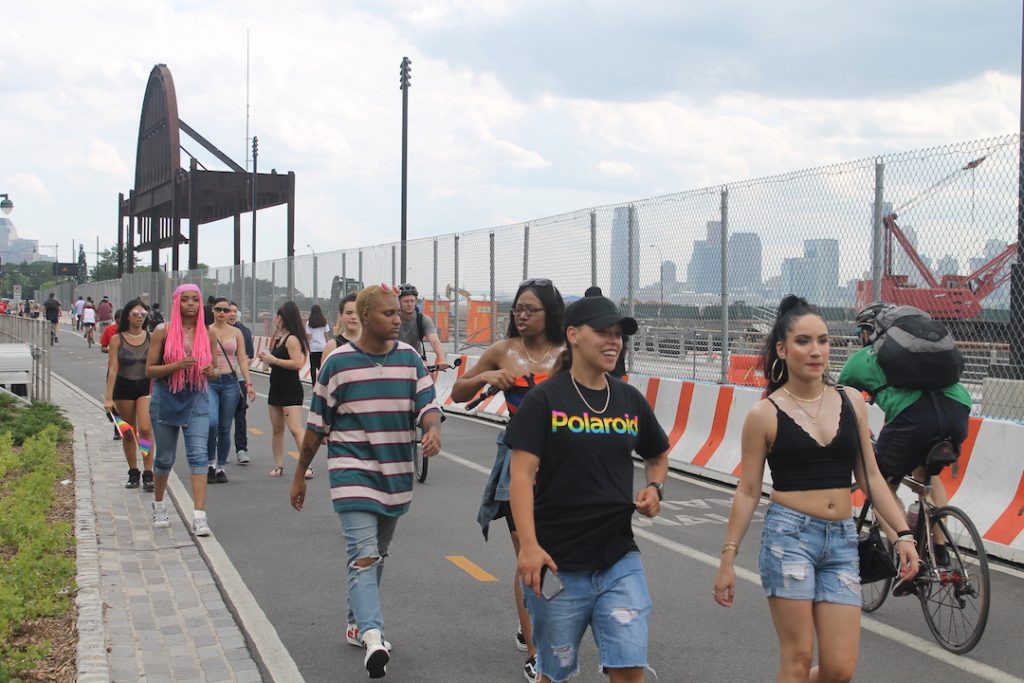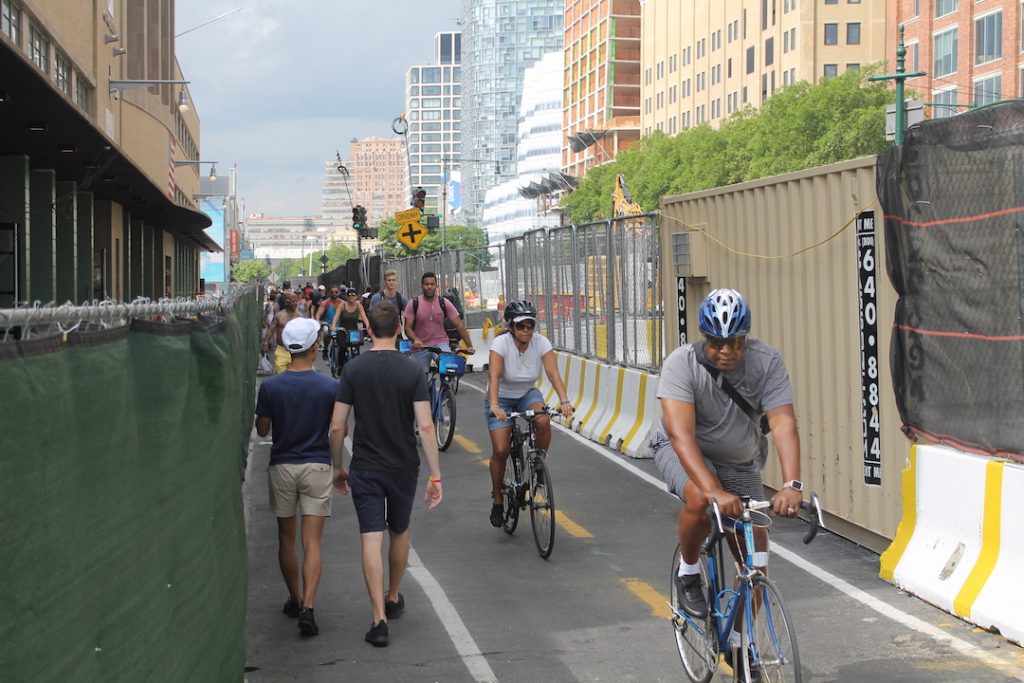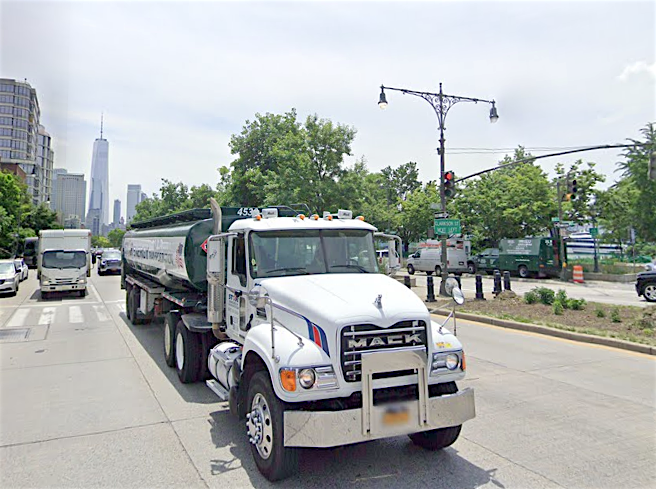BY THE VILLAGE SUN | Talk about open streets — Community Board 2 wants an open highway!
Or at least part of one.
During the coronavirus pandemic, social-distancing requirements have sent New Yorkers flocking to the parks. But that has caused its own issues.
In Hudson River Park, crowding on the Christopher St. Pier caused alarm last month.
The impact has also been felt on the adjacent Hudson River greenway — already the nation’s busiest bike path — which has been hammered during the health crisis.
C.B. 2, though, is now proposing a solution: Take away one lane of traffic from car drivers on the West Side Highway (also variously known as Route 9A, West St. and the Joe DiMaggio Highway) and give it exclusively to bicycle riders.
On May 13, Carter Booth, C.B. 2 chairperson, and Daniel Miller, the board’s first vice chairperson, pitched the proposal in a letter to Governor Cuomo; Marie Dominguez, the state Department of Transportation commissioner; and Erik Kulleseid, the state Department of Parks commissioner.

Booth and Miller’s letter notes that C.B. 2, which includes Hudson River Park from Canal St. to 14th St., and stretches east to Bowery/Fourth Ave., has only .58 acres of parkland per 100,000 residents — “one of the lowest ratios of public open space in New York City,” they wrote — whereas the citywide standard is 2.5 acres.
“Hudson River Park accounts for the largest portion of active and passive open space for C.B. 2 residents,” the two board members stated, adding, “The Hudson River Park Greenway…is the busiest bicycle highway in North America.”
That combination is exacerbating long-simmering issues, especially in terms of crowding on the bike path. The bikeway is technically under the jurisdiction of state D.O.T. but is managed by the Hudson River Park Trust.
“Coronavirus restrictions have placed even more pressure than usual on Hudson River Park and the adjacent bikeway,” their letter continued. “The park is now filled with parents pushing baby strollers, dog walkers, leisure walkers, and slow-moving cyclists mixed in with runners, racing cyclists and electric bicycle messengers fulfilling orders.”
Meanwhile, antiterrorism barriers — added on the bikeway after the 2017 Halloween track attack that killed eight people — are causing bottlenecks, which is only worsening the crowding, they said.
All of the current “multiple-use congestion” and crowding in the park not only increases the chance of collisions but also the potential spread of COVID-19, Booth and Miller warned. They expressed particular concern over the “spray” from mask-defying cyclists and joggers.

“What’s more,” they noted, “social distancing may be effective at 6 feet when walking leisurely, but safe distance requirements expand many more feet when considering the spray of mask-less fast-moving runners and cyclists. Some parkgoers, particularly the fast-moving runners and cyclists, are blatantly disregarding orders of the Mayor, Governor and C.D.C. regarding wearing masks and practicing physical distancing while outside.
“Clearly,” the two C.B. 2 leaders wrote, “this situation calls for a reallocation of the limited space available in the Hudson River Park’s current configuration.”
In short, the board is asking that the greenway be shifted into the westernmost lane of the West Side Highway, where it would be protected with concrete Jersey barriers and cones. Just as the greenway is now, this new bike thoroughfare would be two-way. The bikeway-on-the-highway should be reserved exclusively for cyclists, the board says.
Moving the bikeway onto Route 9A, the letter continues, would then “free up space on the [original] greenway for runners and rollerbladers and provide more room for pedestrians to move within the park.”
Under the proposal, runners and rollerbladers would have exclusive use of the existing bikeway.
C.B. 2 suggests that the proposed West Side Highway bikeway also be extended farther along the highway through Community Boards 1 and 4, which border C.B. 2 to the south and north, respectively — so that it would run from 59th St. all the way down to the Battery.
Booth and Miller concluded their letter by noting that, with the summer and the economy’s reopening, there would be even more pressure on both the Hudson River Park and the bikeway. And with ridership of mass transit way down, more people will be bicycle commuting, they added.
“[A]s the weather warms and reopening phases are implemented, workers will begin to return to their offices and will need transport to get there,” they said. “Studies have indicated workers will consider avoiding public transportation, opting instead for alternative methods of transportation, like cycling and personal vehicle transport.”
In the period since the board’s letter of May 13, the city’s temporary “open streets” initiative has helped relieve some of the pressure on neighborhood parks.
Yet, speaking last week, C.B. 2 Chairperson Booth said the board’s letter asking to make a lane of the West Side Highway a bike path is a “standing request,” meaning the board is still on record advocating for it during the COVID-19 crisis.
As of last week, though, neither Cuomo nor the two commissioners had responded to Board 2’s proposal.


Having been screamed at by cyclists barreling down the existing Hudson River bikeway for legally crossing the crosswalk as a pedestrian on what they consider their turf and expecting me to stop and wait for them to whiz by, I certainly support the West Street bikeway. Sometimes you have to run to get out of their way. They also at times decide to use the esplanade / walkway along the river and slowly pedal along forcing people into making awkward out-of-their way moves. I am all for bikes. I think that it is great and it is healthy. But the bikers that I am addressing are the speed freaks who should be on a professional bike track out on Long Island.